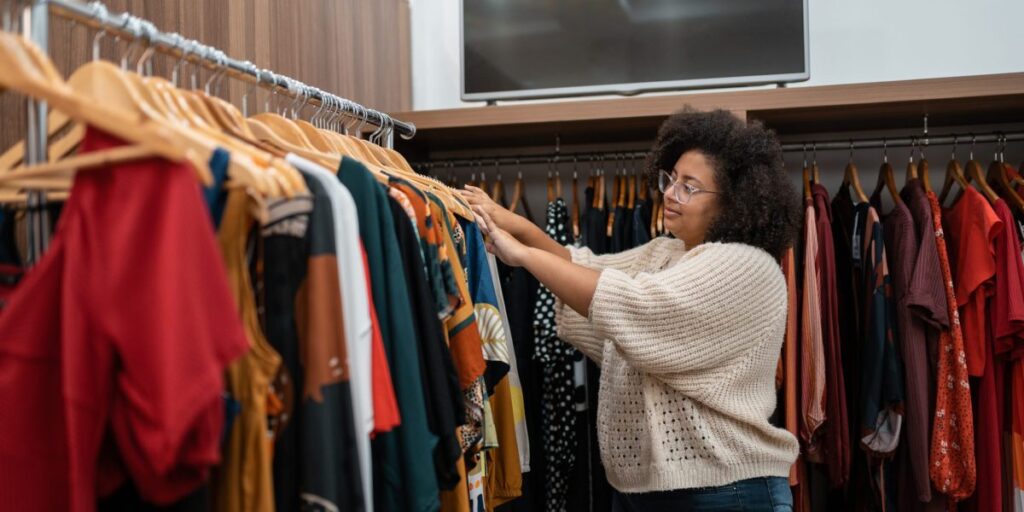Luxury resellers are taking note: Ozempic and Wegobee users are using weight loss as a shopping spree. The secondhand luxury fashion market has noted that people who are losing weight are getting rid of old clothes, and the growing popularity of obesity drugs could be fueling the trend.
Secondhand fashion platform Poshmark revealed that it has seen a 103% increase in the number of plus-size clothing listings over the past two years, including a 103% increase in 3XL listings, an 80% increase in 4XL listings, and a 73% increase in 5XL listings, Vogue Business reported. Poshmark also noted a 78% increase in new items that include the word “weight loss” in the description or listing title.
“With the rise of these new medications, Poshmark is excited to help our customers make even more life changes,” Tracy Sun, Poshmark’s co-founder and vice president of merchandising, told Vogue Business. “We’ve noticed shifts in demand and supply, and we’re closely monitoring these trends to meet our customers’ needs.”
Coupled with Americans clearing out their plus-size clothes, GLP-1 users are searching for new wardrobes. Jennifer Hyman, co-founder and CEO of designer apparel rental platform Rent the Runway, has noticed her company’s customers buying smaller sizes more than they have in the past 15 years. High-end fashion and luxury brands like Lafayette and Amarra have also noticed the trend.
It stands to reason that these buying patterns could be linked to an increase in consumers using weight-loss drugs, Lee O’Donnell, vice president of consulting at market research firm Kantar, told Fortune. People who are trying to lose weight tend to turn to the secondhand market rather than buying new clothes because they’re re-wearing different sizes of clothes over and over again. People who are getting rid of old clothes that no longer fit them could earn points through resale platforms, which could motivate them to shop there, O’Donnell argued.
But for people trying to reach their weight goal for the first time, shopping has an added allure: the possibility of developing a personal style. As Ozempic users change their grocery and household shopping habits to favor nutritious and high-quality products, they might also adopt the same approach when it comes to their wardrobe.
“You may not want to choose disposable clothing, especially if you’re trying to reinvent yourself,” O’Donnell says.
Ozempic revolutionizes consumer products
Roughly one in eight Americans has tried GLP-1 inhibitors like Ozempic or Wegobee, so it’s no surprise that changing body shapes and sizes are inspiring action in the fashion industry, which has struggled amid sluggish consumer confidence, with apparel and accessory sales down 0.9% year over year as of May, according to U.S. Census Bureau data.
Ozempic’s shakeup may mean even more good news for the second-hand luxury industry, which has bucked the fashion industry’s downward trend. Luxury resale is already growing twice as fast as the main luxury market, as consumers with inflation-hit pricey tastes look for affordable alternatives to their favorite brands. The luxury resale market is expected to reach $49 billion in 2023, growing 1% to 4% this year, according to management consultancy Bain & Company.
Other industries have already jumped on the chance to appeal to the expanding consumer base of Ozempic users: Nestle has launched a line of portioned frozen meals aimed at users of GLP-1 drugs, and WW International (formerly Weight Watchers) has launched a plan to offer weight-loss drugs like Wegobee.
But such a major shift is risky, as the long-term effects of these drugs are largely unknown, and many people regain the weight they lose when they stop taking them. Ozempic may be all the rage now, but the long-term effects of its consumer products are still largely unknown.
There are risks to the fashion market trying to keep up with the times: People taking weight-loss drugs may be looking for new clothes, but may not be ready to make luxury purchases until they reach their desired weight, O’Donnell said.
“Almost everyone I’ve spoken to qualitatively about GLP-1 has said, ‘We’re making good progress, but it’s not enough, so I’m going to hold off,'” she said.
This isn’t just a problem for the secondhand market: As clothing sizes shrink, clothing manufacturers can experience growing pains as they try to adapt, according to Prashant Agrawal, founder and CEO of AI-based forecasting firm Impact Analytics. The firm found that as more people use weight-loss drugs, retailers are compensating by changing size models to accommodate smaller body types.
Size curves, or the array of sizes retailers offer consumers, have always been a guesswork model of inventory. Introducing the variable of shoppers looking for smaller clothes makes determining the size curves even more difficult. Getting these curves wrong can cost clothing companies $20 million a year in unused inventory and wasted resources.
“Retailers need to monitor this,” Agrawal said in a statement. “This is a sustainability issue. We can’t make something that won’t be used.”
Check out our new special issue: A Wall Street legend gets a dramatic makeover, cryptocurrency shenanigans, bad-tempered poultry royalty, and more. Read the stories.
Source link



